Nebuchadnezzar II (r. 604–562 BC)
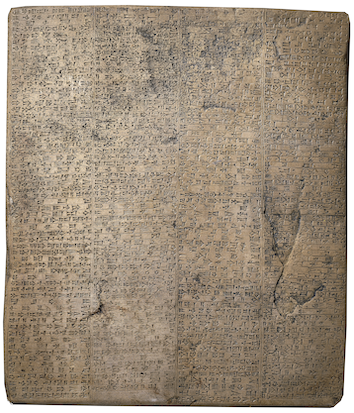
BM 129397, a large stone tablet that bears a long Akkadian inscription that is now commonly referred to as the "East India House Inscription." This text records some of Nebuchadnezzar II's building projects, especially those at Babylon and Borsippa. Image adapted from the British Museum Collection website. Credit: Trustees of the British Museum.
During his very long reign, Nebuchadnezzar II, the son and immediate successor of the founder of the Neo-Babylonian Empire (Nabopolassar), sponsored building activities in at least thirteen Babylonian cities. The transformation of Babylon into an imperial megacity was by far his greatest achievement. In his capital, building on what his father had started, Nebuchadnezzar is known to have worked on no less than thirteen temples, as well as the massive ziggurat; renovated one palace and constructed an additional two royal residences; completed and expanded the inner and outer city walls, together with their embankment walls; redug and improved at least one major canal; and raised and repaved the Processional Way. Presumably, he did more at Babylon, which he transformed in an "object of wonder," than what is presently known from available cuneiform sources and from the archaeological record. This Neo-Babylonian ruler was undoubtedly one of the most active Mesopotamian builders. From extant textual sources, mostly royal inscriptions, Nebuchadnezzar's main building projects are:
- Agade
- Eulmaš (temple of the goddess Ištar)
- Babylon
- Ay-ibūr-šābû (Processional Way of the god Marduk)
- Duku ("Dais of Destinies ," seat of the god Marduk as Lugaldimmeranki in Ubšukkina in Esagil)
- Edikukalama (temple of the god Šamaš)
- Ehursagsikila (temple of the goddess Gula/Ninkarrak)
- Ekišnugal (temple of the god Sîn)
- Ekitušgarza (temple of the goddess Ištar as Bēlet-Eanna)
- Ehursagtila (temple of the god Ninurta)
- Emah (temple of the goddess Bēlet-ilī)
- Emašdari (temple of the goddess Ištar of Agade)
- Enamhe (temple of the god Adad)
- Eniggidrukalamasuma (temple of Nabû of the harû)
- Esabad (temple of the goddess Gula)
- Esagil (temple of the god Marduk)
- Ešasurra (temple of the goddess Išhara)
- Esiskur (New Year's temple of the god Marduk)
- Etemenanki (ziggurat of the god Marduk), together with its gates Kanunabzu, Kanunhegal, Kaunir, and Kaetemenanki
- Eumuša (cella of the god Marduk)
- Ezida (the cella of the god Nabû)
- Imgur-Enlil and Nēmetti-Enlil (the inner city walls), together with its eight gates, especially the Ištar Gate (Ištar-sākipat-tēbîša)
- Ištar-lamassi-ummānīša (part of the Processional Way of the god Marduk)
- Kahilisu (gate of Edara'ana, the cella of the goddess Zarpanitu)
- Lībil-hegalla (the eastern canal)
- Nabû-dayyān-nišīšu (Processional Way of the god Nabû in Babylon)
- North Palace
- Outer city wall and its gates
- South Palace
- Summer Palace
- Ubšukkina (Ubšukkinamezuhalhala; court of divine assembly)
- Bāṣ
- Edurgina (temple of the god Bēl-ṣarbi)
- Borsippa
- Dais of Destinies (a seat of the god Nabû in the Ezida temple complex)
- Edimana (temple of the god Sîn)
- Egula (temple of the goddess Gula)
- Emahtila (cella of the god Nabû)
- Ešidduannaki (cella of the god Nabû)
- Etila (temple of the goddess Gula/Ninkarrak)
- Eurmeiminanki (ziggurat of the god Nabû)
- Ezibatila (temple of the goddess Gula)
- Ezida (temple of the god Nabû)
-
- Kamah (gate of Ezida)
-
- Kanamtila (gate of Ezida)
-
- Kaumuša (gate of Ezida)
-
- temple of the god Adad (ceremonial name not known)
-
- temple of the god Mār-bīti (ceremonial name not known)
- Ṭābi-supūršu (city wall)
- Cutha
- Emeslam (temple of the god Nergal)
- Ešurugal (temple of the goddess Ereškigal)
- Dilbat
- E-ibbi-Anum (temple of the god Uraš and the goddess Ninegal)
- Isin
- Egalmah (temple of the goddess Gula as Ninisinna)
- Kish
- Edubba (temple of the god Zababa)
- Eunirkitušmah (ziggurat of the god Zababa)
- Larsa
- Ebabbar (temple of the god Šamaš)
- Marad
- Eigikalama (temple of the god Lugal-Marda)
- Sippar
- Ebabbar (temple of the god Šamaš)
- Ekunankuga (ziggurat of the god Šamaš)
- Eula (temple of the goddess Gula as Ninkarrak)
- Ur
- Ekišnugal (temple of the god Sîn)
- Uruk
- Eanna (temple of the goddess Ištar)
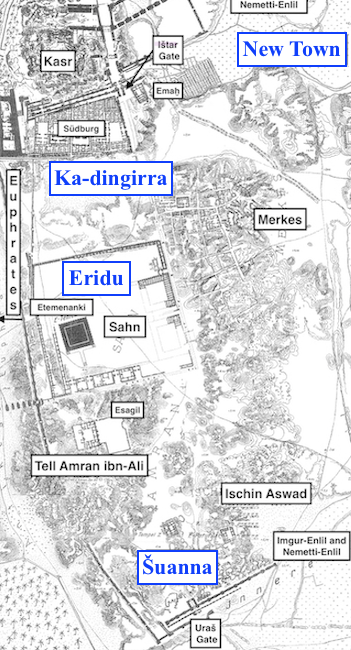
Annotated plan of the ruins of East Babylon. Adapted by Jamie Novotny from Koldewey, Das wieder erstehende Babylon, fifth edition, fig. 256.
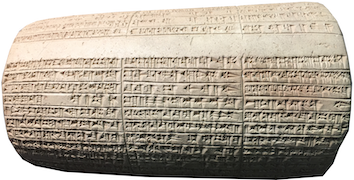
BM 104852, a three-column clay cylinder with an Akkadian inscription recording Nebuchadnezzar II's rebuilding of Eigikalama at Marad. Photo: Jamie Novotny.
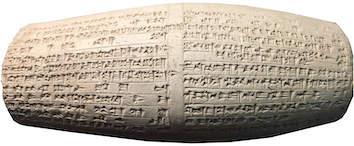
BM 091101, a two-column clay cylinder with an Akkadian inscription recording Nebuchadnezzar II's rebuilding of Ebabbar at Sippar. Photo: Frauke Weiershäuser.
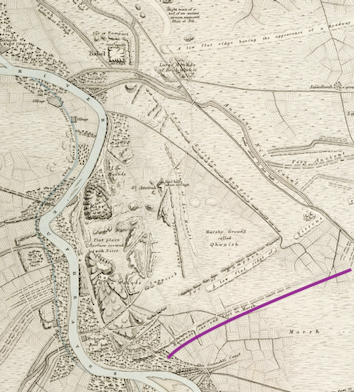
A map of Babylon and its surroundings prepared by William Selby in the late 1850s. The traces of a wall south of the eastern outer wall (above the purple line) might be the remains of a cross country defensive wall. Image: W.B. Selby, William and W. Collingwood, Plan of the supposed ruins of Babylon.
In addition, Nebuchadnezzar's inscriptions record that he had at least two other walls (or earthen ramparts with baked-brick sides) constructed. The first stretched from Babylon to Kish and then from Kish to Kar-Nergal and then rot the Tigris river. The second — which has been partial excavated and surveyed — was built just north of Sippar and it also ran the entire stretch between the Tigris and Euphrates Rivers, from Sippar to Up. The latter has been partial excavated and surveyed. An Akkadian inscription written on clay cylinders records the following:
Perhaps in connection with this work, or the rebuilding of the Nergal temple Emeslam, this Neo-Babylonian king had a water-filled moat (Akkadian hirītu) dug around the city of Cutha.
Moreover, archaeological evidence from other sites have yielded evidence for Nebuchadnezzar undertaking construction in those Babylonian cities. These include Abu Qubur (not to be identified with ancient Durbissu), Hursagkalama (modern Tell Ingharra), Jemdet Nasr (or its surroundings), Kissik (modern Tell al-Laḥm), Seleucia, and Sippar-Anunītu (modern Tell ed-Der).
Jamie Novotny & Niclas Dannehl
Jamie Novotny & Niclas Dannehl, 'Nebuchadnezzar II (r. 604–562 BC)', Babylonian Temples and Monumental Architecture online (BTMAo), The BTMAo Project, a sub-project of MOCCI, [http://oracc.org/btmao/StructuresbyBuilder/Neo-BabylonianEmpire/NebuchadnezzarII/]